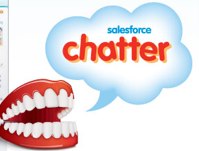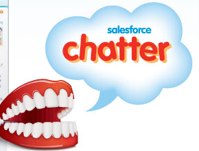
Salesforce’s enterprise friendly social collaboration platform Chatter was announced at last year’s November Realtime CrunchUp with much fanfare. To many, there is no doubt that Chatter will have a lasting impact on the enterprise and cloud computing. Following Salesforce’s debut of Chatter, over 67,000 Salesforce customers requested to be private beta testers of the realtime collaboration platform. Today, a lucky 100 large and small businesses, including Reed Exhibitions, Schumacher Group, and TransUnion, will begin to use Salesforce Chatter as the platform enters private beta.
Salesforce says that private beta participants were chosen based on their existing Salesforce.com technology deployments and potential Chatter use cases. Chatter itself as a platform has much of the same functionality as when the platform first debuted. One addition is the integration of Chatter to Saleforce’s iPhone and BlackBerry apps, allowing users to tap into Chatter’s realtime stream on the go. Chatter will be integrated into the new Salesforce homepage along with a dashboard of reports and approvals, workflow, tasks and calendar. You’ll also be able to see filters as well. Chatter will let you see updates from people, files, applications, HR, and will integrate other feeds (Dow Jones, Thompson Reuters).
Similar to Facebook, employees can create business profiles with professional information like personal contact data, area of expertise, and work history. Searching other people’s profiles, colleagues can quickly identify individuals who are relevant to their enterprise needs. Users can post status updates to share communications, files and links around a project, sales deal or customer support case. And users can see realtime feeds of personalized updates from people, applications and documents. With Chatter, all status updates from a customer’s Sales Cloud, Service Cloud or custom Force.com application are posted to the feed. So apps actually have the ability to post status updates, similar to a person, creating an actual ecosystem around apps and employees. Any app listed on Salesforce.com’s AppExchange will be able to stream updates to the Chatter feed. Since they are delivered on the Force.com platform, developers can build or enhance cloud applications to use Chatter’s profiles, realtime streams, and APIs.
Sharing is a huge component of Chatter, with users having the ability to search the Chatter feed to access, share and download any materials. And employees can manage who has has access to certain information. Chatter wouldn’t be a viable communication platform for the enterprise if it didn’t integrate with consumer social networks. Chatter allows employees to pull in social media information from Facebook and Twitter to gain insights into customer satisfaction and the greater community. For example, employees can monitor the Twitter conversation about a particular prospect or competitor from within Chatter. Chatter is also deeply integrated with Google Apps.
Salesforce Chatter will be included for free in all paid editions of Salesforce CRM and the Force.com platform. If businesses don’t use either of these products, they can pay $50 per user per month which will include Salesforce Chatter, Salesforce Content and Force.com. Salesforce will also be rolling out a lightweight free version of Chatter. At the moment, Salesforce is being cagey about when Salesforce will be available to the general public, but we expect that it should be rolled out at some point this year.
Chatter sounds a lot like an enterprise-friendly social network, but Salesforce CEO and founder Marc Benioff is adamant that the product is best characterized as a collaboration platform. In fact, Salesforce doesn’t see its main competitors as Facebook, Twitter or even enterprise friendly social networks like Jive. Instead, the company believes Chatter will pose a serious threat to Microsoft’s Sharepoint and IBM’s LotusNotes. Both of the latter products are used heavily by enterprises for hosted communication. Social CRM startups like Bantam Live are already in the market with competing offerings.
The private beta of Chatter represents the unveiling of a brand new strategy for Salesforce, which is the incorporation of the realtime stream within the enterprise. It should be interesting to see the feedback from businesses both small and large on how useful Chatter is for day-to-day business. It’s not a definite that Chatter will revolutionize collaboration in the enterprise, but its sure to be exciting to see if the platform can gain serious traction.
